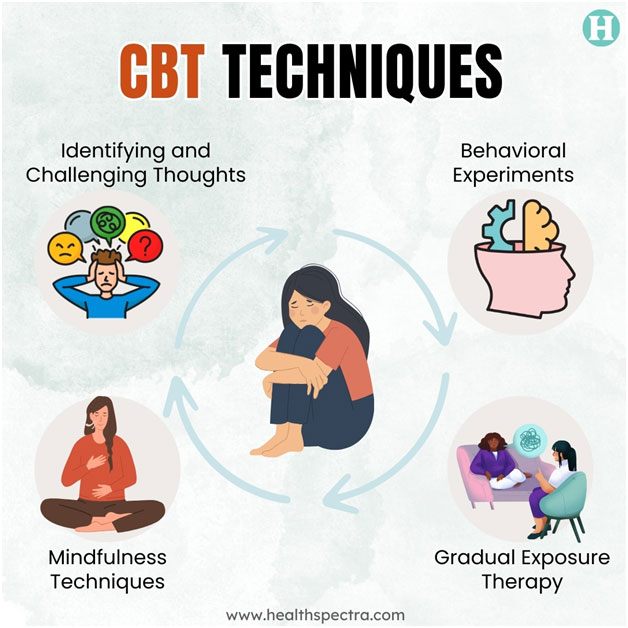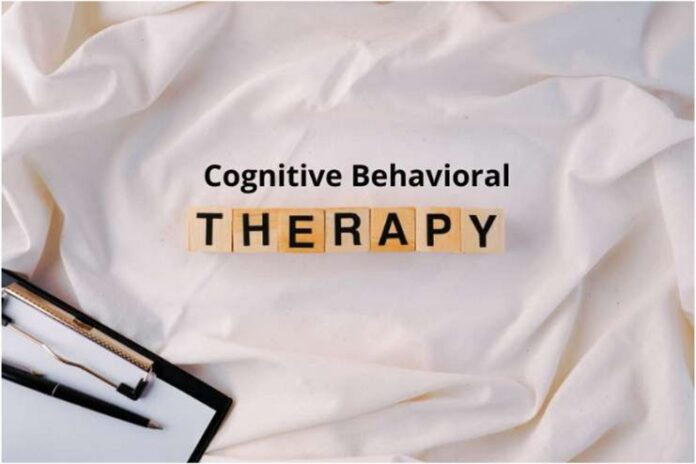Affiliate Disclaimer
Some links in this article are affiliate links. We may earn a small commission if you make a purchase through these links, at no extra cost to you. We only recommend products we find useful to our readersCognitive Behavioral Therapy (CBT) is a scientifically supported and effective method for treating anxiety disorders. CBT is based on the idea that our thoughts, feelings, and behaviors are interconnected. By addressing and changing negative thought patterns, CBT helps individuals manage and overcome anxiety, promoting long-term resilience. This approach equips people with valuable tools to navigate the challenges anxiety brings.
Anxiety has become a widespread mental health issue, affecting people of all ages and backgrounds. Whether it’s social anxiety, panic disorder, or generalized anxiety disorder (GAD), the impact of anxiety is profound. This article explores how CBT serves as a powerful tool for managing anxiety.
What Is Anxiety and How CBT Helps

Anxiety disorders are characterized by excessive, persistent fear or worry that can interfere with daily life. While everyone experiences occasional anxiety, those with anxiety disorders often struggle with persistent symptoms that worsen over time.
Types of anxiety disorders include:
- Generalized Anxiety Disorder (GAD): Individuals with GAD experience intense anxiety or worry regularly for several months, if not years. They could have agitation, jitters, or fatigue easily. Additionally, they might be tense in their muscles, have trouble sleeping, or have difficulty concentrating.
- Panic Disorder: This disorder involves recurrent and unexpected panic attacks, which can occur without warning. These attacks are intense and are often accompanied by symptoms such as rapid heartbeat, chest pain, shortness of breath, dizziness, and feelings of impending doom.
- Social Anxiety Disorder: Individuals with social anxiety experience an overwhelming fear of being judged, criticized, or embarrassed in social situations. This fear can make it difficult to participate in everyday activities like attending work meetings, school, or social events.
- Phobias: Phobias involve an intense, irrational fear of specific objects or situations, such as heights, flying, or spiders. Unlike general anxiety, phobias are typically triggered by a particular stimulus and lead to avoidance behaviors.
When treating anxiety disorders, CBT offers a systematic and goal-oriented approach. By helping individuals identify and change the negative thought patterns that contribute to anxiety, CBT empowers people to break free from the cycle of worry and fear. With consistent practice, individuals can develop more balanced thinking patterns, healthier behaviors, and improved coping strategies.
Core CBT Techniques
 CBT incorporates a range of techniques designed to help individuals address both their cognitive (thought) and behavioral patterns. Here are some of the core techniques used in CBT for managing anxiety:
CBT incorporates a range of techniques designed to help individuals address both their cognitive (thought) and behavioral patterns. Here are some of the core techniques used in CBT for managing anxiety:
1. Identifying and Challenging Thoughts
A key component of CBT is recognizing and challenging unhelpful or distorted thought patterns that fuel anxiety. One of the primary strategies for this is cognitive restructuring, which involves identifying automatic negative thoughts and critically evaluating them. This process helps individuals understand that their thoughts are often not based on reality and can be reframed into more realistic, balanced perspectives.
“The first step in Cognitive Behavioral Therapy is realizing that our anxious thoughts aren’t as realistic as we think,” says Dr. Elizabeth R. McIngvale, a licensed therapist who specializes in anxiety disorders.
“We actually become blind and deaf if our intellect is hampered by erroneous interpretations, distorted symbolic meanings, and illogical reasoning,” says Dr. Aaron T. Beck – founder of Cognitive Behavior Therapy (CBT) and one of the world’s foremost authorities on psychopathology.
Patients can begin to escape the cycle of anxiety by questioning these ideas and substituting evidence-based, logical cognition for fear.
People with anxiety tend to engage in cognitive distortions—patterns of thinking that amplify worry and fear. Common cognitive distortions include:
- Catastrophizing: Expecting the worst possible outcome in any given situation.
- Overgeneralization: Making broad, sweeping conclusions based on a single incident.
- Black-and-white thinking: Seeing situations as all good or all bad, with no middle ground.
For example, someone preparing for a job interview might think, “If I don’t perform perfectly, I’ll never get a job again.” By using cognitive restructuring, this thought can be reframed to, “It’s normal to make mistakes, and one interview doesn’t define my entire career.”
Cognitive restructuring involves more than simply challenging thoughts; it’s a process that uses various techniques, such as decatastrophizing, thought recording, and guided questioning, to help individuals reframe distorted thinking patterns into more balanced, constructive thoughts.
Although experts advise employing cognitive restructuring with a cognitive behavioral therapist, the technique can be applied to reframe less severe, everyday negative beliefs. It can be used, for instance, to prepare psychologically for a party or a public presentation.
2. Behavioral Experiments
In addition to addressing thoughts, CBT incorporates behavioral experiments—a technique that allows individuals to test the validity of their anxiety-driven beliefs in real-world situations. This method helps individuals gather evidence that challenges the distorted thoughts that fuel their anxiety.
For example, someone with social anxiety might believe, “If I attend a party, people will think I’m awkward and won’t want to talk to me.” Through a behavioral experiment, the individual might go to the party and observe how others react, often discovering that their fears are exaggerated. This process helps individuals see that their beliefs may not be accurate and empowers them to break free from avoidance behaviors.
Behavioral experiments are a form of experiential learning, where individuals test their beliefs and assumptions by collecting real-world data to challenge their fears.
3. Exposure Therapy and Response Prevention
Another powerful CBT technique is Exposure Therapy, particularly Exposure and Response Prevention (ERP). This technique is especially helpful for individuals with phobias, obsessive-compulsive disorder (OCD), or other anxiety disorders that involve avoidance behaviors.
The goal of exposure therapy is to reduce fear and anxiety by gradually exposing individuals to feared situations or objects in a controlled manner. The exposure is typically done in stages, starting with less anxiety-provoking situations and progressively moving toward more challenging ones.
“As psychologists in our program for anxiety disorders, we frequently suggest exposure therapy to our patients. It makes sense that patients may be reluctant at times. We are aware that when patients comprehend what they are doing and why, treatment is more effective.” Stefanie Russman Block, Ph.D.
For example, someone with a fear of public speaking might begin by speaking in front of a mirror, then progress to a small group of friends, and eventually work up to speaking in front of a larger audience. By confronting their fear in a gradual, systematic way, individuals learn that their anxiety decreases over time as they face their fears rather than avoiding them.
Response Prevention is a crucial aspect of ERP Therapy, especially for individuals with OCD. It involves preventing the compulsive behaviors (e.g., hand washing or checking) that individuals use to alleviate their anxiety. By resisting these compulsions, individuals learn that their anxiety will naturally subside over time, reinforcing their ability to tolerate discomfort without engaging in avoidance behaviors.
4. Mindfulness Techniques
Mindfulness, which involves cultivating awareness and acceptance of the present moment, is a key component of CBT. Mindfulness techniques help individuals break the cycle of rumination, which often fuels anxiety, by teaching them to focus on the here and now rather than getting lost in worries about the future or regrets about the past.
Mindfulness practices include techniques like body scan meditation or progressive muscle relaxation, where individuals focus on the sensations in each part of their body, and deep breathing exercises, which promote relaxation and help regulate the body’s stress response.
By integrating mindfulness into CBT, individuals can develop greater self-awareness and learn to observe their thoughts and feelings without judgment. This helps reduce the emotional intensity of anxiety and provides individuals with tools to manage distressing thoughts more effectively.
Real-Life Success Stories: How CBT Helped People Overcome Anxiety

Julia, a 31-year-old client with low self-esteem:
“I was practically friendless, weak in self-esteem, uneasy at work, and unwilling to move past what some individuals had done in the past when I scheduled my initial examination. After roughly nine CBT sessions, I genuinely feel like a changed person. Things don’t appear as harsh or dismal as they used to because I’ve changed the way I think.”
Paul, a 55-year-old client with generalized anxiety
“My CBT treatments have equipped me with the skills and self-assurance I need to manage my generalized anxiety disorder and its associated challenges. I’ve learned a lot of techniques to reduce my worries, particularly with regard to the future. My CBT expert gave me valuable information to take away from the sessions and used language I could comprehend to explain the science and causes of my emotions. I never thought I could do anything to stop worrying, but CBT has made life easier.”
Implementing CBT Techniques
The effectiveness of CBT lies not just in the therapy session but also in its application in everyday life. To get the most out of CBT, individuals are encouraged to incorporate these techniques into their daily routines.
- Thought Journals: Keeping a thought journal helps individuals identify automatic negative thoughts and evaluate their validity. Writing down these thoughts allows people to challenge them more easily and reframe them with healthier alternatives.
- Cognitive Restructuring: Practice cognitive restructuring regularly by identifying cognitive distortions in everyday situations and replacing them with more balanced and rational thoughts.
- Mindfulness Practices: Set aside time each day to practice mindfulness techniques, such as breathing exercises or body scans. These practices can be done during breaks at work, while commuting, or at home.
By integrating these CBT techniques into daily life, individuals can build long-term coping strategies, gain greater self-awareness, and reduce the overall impact of anxiety.
Professional Assistance and Support

While self-help strategies can be valuable, working with a trained therapist can significantly enhance the effectiveness of CBT. A professional can tailor the techniques to suit individual needs, guide through difficult moments, and offer additional support as individuals navigate the complexities of anxiety.
Therapists can also help individuals identify and address underlying issues that may contribute to anxiety, such as past trauma or unhelpful coping mechanisms. With the support of a therapist, CBT can be customized to meet each person’s unique needs, ensuring that the techniques are both effective and sustainable.
Conclusion
Cognitive Behavioral Therapy (CBT) is a well-established and highly effective approach for managing anxiety disorders. By focusing on the interconnections between thoughts, emotions, and behaviors, CBT helps individuals identify and challenge distorted thinking patterns, confront feared situations, and develop healthier coping strategies. Whether treating panic attacks, social anxiety, or phobias, CBT offers a comprehensive framework for managing anxiety and promoting mental well-being.
For those seeking lasting relief from anxiety, CBT is a proactive and structured approach that can be tailored to fit individual needs. Working with a trained therapist can further enhance the effectiveness of CBT, helping individuals build resilience and achieve long-term mental health benefits.
References
- https://www.nimh.nih.gov/health/topics/anxiety-disorders
- https://magazine.medlineplus.gov/article/4-types-of-common-anxiety-disorders
- https://www.webmd.com/anxiety-panic/anxiety-disorders
- https://focus.psychiatryonline.org/doi/10.1176/foc.4.2.173
- https://www.verywellmind.com/what-is-cognitive-behavior-therapy-2795747
- https://www.ncbi.nlm.nih.gov/pmc/articles/PMC4610618/
- https://www.verywellmind.com/what-is-cognitive-restructuring-3024490
- https://positivepsychology.com/cbt-cognitive-restructuring-cognitive-distortions/
- https://www.verywellmind.com/how-to-perform-behavioral-experiments-4779864
- https://www.psychologytools.com/resource/behavioral-experiment/
- https://www.verywellmind.com/exposure-therapy-definition-techniques-and-efficacy-5190514
- https://www.apa.org/ptsd-guideline/patients-and-families/exposure-therapy
- https://www.mcleanhospital.org/essential/erp
- https://iocdf.org/about-ocd/treatment/erp/
- https://www.medicalnewstoday.com/articles/progressive-muscle-relaxation-pmr
- https://www.ncbi.nlm.nih.gov/pmc/articles/PMC8272667/
- https://www.sciencedirect.com/topics/medicine-and-dentistry/progressive-muscle-relaxation
- https://www.mayoclinic.org/healthy-lifestyle/consumer-health/in-depth/mindfulness-exercises/art-20046356
- https://www.ncbi.nlm.nih.gov/pmc/articles/PMC2848393/
- https://www.ncbi.nlm.nih.gov/pmc/articles/PMC3679190/
- https://drmessina.com/practice-cognitive-behavioral-therapy-at-home/
- https://www.nacbt.org/whatiscbt-htm/
In this Article




















